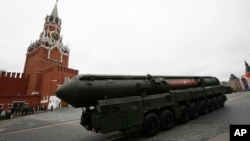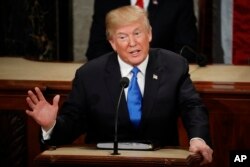The United States says it is confident that both the U.S. and Russia will have honored their commitments under the bilateral Strategic Arms Reduction Treaty (New START) by the Monday deadline.
U.S. State Department spokesperson Heather Nauert said there is good news to report on deadline day, which is also the eighth anniversary of the new Start treaty taking effect.
“The United States has met the central limits of the New Start treaty in August 2017. We assess at this time that Russia has also progressed toward meeting those limits. We have no reason to believe that the Russian government will not meet those limits as well.”
The State Department said in a release late Sunday that both countries will exchange data on their respective nuclear arsenals “within the next month, as we have done twice per year over the last seven years in accordance with the Treaty.”
Treaty signed in 2010
The New START Treaty was signed in Prague on April 8, 2010 by then U.S. President Barack Obama and then Russian President Dmitry Medvedev and came into force on Feb. 5, 2011.
It limits the U.S. and Russia to no more than 1,550 nuclear warheads and also limits deployed and non-deployed intercontinental ballistic missiles, heavy bombers and submarine-launched ballistic missiles.
Under the treaty, both sides are to exchange information twice a year on the number of warheads and delivery vehicles, and are allowed to conduct on-site inspections to verify each other’s compliance.
Olga Oliker is the Director of the Russia and Eurasia Program at the Center for Strategic and International Studies in Washington. She told VOA the ability to deploy “boots on the ground” for inspections helps build trust.
“It limits your incentives to try to cheat, and it gives everyone also the opportunity to meet one another and to actually build relationships that are based on verifying compliance with the treaty that everyone agreed to.”
Trump calls for upgrade
At his State of the Union speech last week, President Donald Trump outlined his approach to nuclear weapons.
“We must modernize and rebuild our nuclear arsenal, hopefully never having to use it, but making it so strong and powerful that it will deter any acts of aggression. Perhaps someday in the future there will be a magical moment when the countries of the world will get together to eliminate their nuclear weapons. Unfortunately, we are not there yet.”
Experts say despite a widening rift between Moscow and Washington on Russia’s election interference, Syria, Crimea, Ukraine and other issues, the fact that both sides are still cooperating and complying with nuclear monitoring and verification is crucial to global security and stability.
Treaty is crucial
Olga Oliker says the disagreements between Washington and Moscow make the treaty even more crucial.
“I think the United States and Russia disagree on a great many things and have some interests that are very misaligned. This means all the more that we need to work to make sure that our disagreements don’t escalate and that if they do get worse, we don’t run the risk of blowing up the world many times over.”
Oliker says the New START treaty is key to global security and stability because the U.S. and Russia have about 95 percent of the world’s nuclear weapons.














